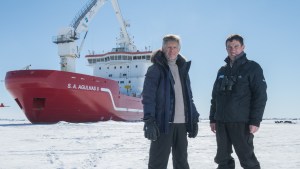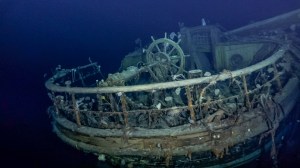EXCLUSIVE: When Dr. John Shears led the 2022 expedition to find Sir Ernest Shackleton’s ship the Endurance, a former boss gave him a 10% chance of success. “I said to him: ‘Well, Shackleton would have taken that chance,’” he tells Deadline. The extraordinary tale of the effort to find the famous explorer’s ship plays out alongside jaw-dropping newly color-treated footage of the original expedition in Endurance. The feature documentary comes from the Oscar-winning team of Chai Vasarhelyi and Jimmy Chin and Bafta-nominated Natalie Hewit.
In their first interview about the project, Vasarhelyi, Shears and producer Ruth Johnston tell Deadline about the film, which meshes historic and modern-day adventure. The film will air on Nat Geo and then stream on Disney+ and Hulu later this fall. It will premiere at the London Film Festival.
Endurance tells the stories of two expeditions. In 1914 Sir Ernest Shackleton set out to traverse Antarctica but his ship got trapped in pack ice and ultimately sank. What followed was an historic tale of survival in the face of adversity. More than a century later the Endurance22 expedition set out on the icebreaker Agulhas II. Led by Dr. Shears, alongside expedition subsea manager Nico Vincent, director of exploration Mensun Bound and historian and broadcaster Dan Snow and an international team of scientists and technologists, their mission was to find the wreck of the Endurance. It had been resting at the bottom of the Weddell Sea for 107 years.
“It is the greatest survival story ever told, and Jimmy and I have always been kind of obsessed,” Vasarhelyi says. “There was something about there being an artifact after they found the boat and also the relationship between the two stories and the spirit of exploration, which is still so exciting and such a huge part of the human condition.
“When the wreck was found, we saw it as a great opportunity to retell the Shackleton story. And now we have the creative tools that can really help bring a story like this to life.”
The wreck of Endurance on the bottom of the Weddell Sea
Falklands Maritime Heritage Trust/National Geographic
Sight and sound: Shackleton in color and full voice
Shackleton kept his crew of 27 men alive for over a year. Luckily for future generations, Australian crew member Frank Hurley recorded events on film. The surviving footage was used in the film South. What Vasarhelyi and the Endurance filmmakers have done for the first time is bring a color-treated version of Hurley’s images to the screen. The British Film Institute controls the footage and gave the team a 4k scan of Hurley’s film and they duly set to work.
Equally remarkably, the filmmakers have used artificial intelligence to create the voices of Shackleton and six of his crew members from fragments of audio recordings. Archive recordings of their voices were adapted by Ukraine-based software outfit Respeecher meaning the men could “read” their diary entries.
“Their personalities really come out through their diaries,” Vasarhelyi says. “Now we have this tool that’s available, if you have a small recording of someone’s voice, you can use their words in their own voice. I didn’t know what the net effect was going to be, how it would actually feel. And then it was like: ‘Oh my God, it’s them.’”
“I just had total chills,” she says about hearing as well as seeing Shackleton and crew. “Chills” is an appropriate word given the polar exploration themes. Indeed, Endurance is not only the name of the sunken vessel but captures the quality Shackleton’s crew needed to survive. Although their lives were not on the line in the same way, Dr. Shears’ Endurance22 expedition also required extraordinary teamwork to surmount enormous challenges.
“They had to fix so many things as they were trying to find the Endurance; they had to keep innovating and innovating and having watched that process and that teamwork, it was really an incredible effort, they were working night and day in freezing conditions like Shackleton and his expedition,” says producer Ruth Johnston. “They just had so many different problems. We couldn’t show the many dives that they went on, but I’m hoping that we’re able to give the audience enough so that they get a sense of that.”
Johnston tells Deadline she has just jumped off a boat to do her interview – although from the more temperate climes of Orcas Island in Washington State rather than the Weddel Sea. She recalls a moment when the team thought they had found Shackleton’s boat and she reported back to Nat Geo. “We showed them a grainy photo and then they said: ‘How do you know it’s the Endurance? Can you show us the back of the ship, can you show us the Pole Star [a five-pointed star symbol known to be on the stern of this ship]?’ The next day, we were able to do that, thanks to that incredible team. It was a wonderful moment to be able to show National Geographic and say: ‘Is this what you’re looking for?’”

Mensun Bound (L) and John Shears (R) on the ice in the Antarctic (Credit: National Geographic/Esther Horvath)
Capturing Endurance22 on film
Dr. Shears wanted his team’s efforts captured on film and the producer combo of Little Dot Studios, Consequential & History Hit Production in association with Little Monster Films came together to oblige. Fitting a film crew around a high-tech and high-pressure expedition, however, came with its own challenges. “The mission was to find Endurance, an incredible challenge that most people told us was absolutely impossible, so technically and in terms of engineering and logistics, it was huge,” he says. “For me as expedition leader, I’ve got to manage all those different activities, but at the same time, it was very important to get that documentary record.
“We were very fortunate that we had Natalie Hewit as the director on board. She had already been to Antarctica and spent three months with the British Antarctic Survey. Having that sort of experience really helped her slot in and be part of the team.”
That experience came in handy given the prevailing conditions. “Towards the end of the expedition it’s coming into the Antarctic winter, minus 18 degrees centigrade, it’s dark outside and there’s real issue of people getting hypothermia, frostnip or frostbite, but the film team were absolutely brilliant, and you can see that in what they recorded on board.”
Dr. Shears had previously led an unsuccessful attempt to find the Endurance and there’s a sense in the film that the stakes are high and reputations are on the line. The team also have personal connections to the Shackleton story.
The expedition leader recalls walking on the ice, 10,000 feet above where the wreck was located. “You’re actually walking in the same footsteps as Shackleton. You can walk a couple of miles away from the ship, and you don’t hear any of the generator humming, people shouting, it’s just you there out in the ice. All you can hear is your own breath, the wind and the ice. Those would be the times that I’d think of Shackleton and how on earth he kept those men alive. It was an incredible feat of leadership.”
For Dr. Shears, the story continued back on dry land where he worked with the filmmakers and editor and producer Bob Eisenhardt, who had previously teamed with Vasarhelyi and Chin on Meru, Free Solo and The Rescue. “It’s been a journey with Jimmy and Chai, going into the studio with them. They’re very respectful to both Shackleton’s and our story and what you see on screen is a very truthful and accurate account of both expeditions. It’s been a fantastic journey, I’m so proud of what they’ve done with the movie.”
When the film has its premiere at the London Film Festival in October the whole 65-person international crew of the Agulhas II will be in attendance. Shears reports that “excitement and anticipation amongst the exhibition team is immense” ahead of them seeing their exploits on the big screen.
As Vasarhelyi anticipates the film coming out, she hopes for a multi-generational audience, and for people to put down their phones for a moment and talk about the historic and modern-day adventures.
“This is a movie you might watch on a Friday night or Thanksgiving, because you’ll end up talking about it and having a conversation, as opposed to everyone being siloed,” she says. “Jimmy and I still really believe in the idea that cinema is about connection. In Free Solo, you remember who you sat next to and who you grabbed, or who cried. I’m excited for people to watch it with their kids and with their parents and then put away phones and talk about stuff for a while.”

